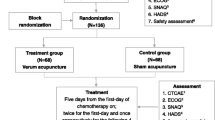Abstract
Goals
In this multicenter crossover study, our aim was to evaluate the efficacy and acceptance of acupuncture as a supportive antiemetic approach during highly emetogenic chemotherapy in pediatric oncology.
Patients and methods
Eleven children receiving several courses of highly emetogenic chemotherapy for treatment of solid tumors were included. Randomization allocated patients to start chemotherapy either with antiemetic medication plus acupuncture or antiemetic medication alone. During all study courses, patients continued to receive their programmed and additional antiemetic medication as needed. Acupuncture was given at day 1 of chemotherapy and at subsequent days on patient’s demand. The amount of baseline and additional antiemetic medication during chemotherapy was documented. Patients maintained a daily diary of vomiting episodes and completed an evaluated nausea score at the end of every course. Their body weight was taken before and after a chemotherapy course.
Main results
Twenty-two courses with or without acupuncture were compared. The benefits of acupuncture in adolescents with respect to the reduction of additional antiemetic medication were observed. Acupuncture enabled patients to experience higher levels of alertness during chemotherapy and reduced nausea and vomiting. Except for needle pain, no side effects were noted. Patient’s acceptance of acupuncture was high.
Conclusion
Our data indicate that acupuncture might reduce antiemetic medication and episodes of vomiting in pediatric oncology.

Similar content being viewed by others
References
Aglietti L, Roila F, Tonato M et al (1990) A pilot study of metoclopramide, dexamethasone, diphenhydramine and acupuncture in women treated with cisplatin. Cancer Chemother Pharmacol 26:239–240
Collins JJ, Byrnes ME, Dunkel IJ et al (2000) The measurement of symptoms in children with cancer. J Pain Symptom Manage 19:363–377
Collins KB, Debera JT (2004) Acupuncture and acupressure for the management of chemotherapy-induced nausea and vomiting. J Am Acad Nurse Pract 16(2):76–80
Dundee JW, Ghaly RG, Fitzpatrick KT et al (1989) Acupuncture prophylaxis of cancer chemotherapy-induced sickness. J R Soc Med 82:268–271
Friedman T, Slayton WB, Allen LS et al (1997) Use of alternative therapies for children with cancer. Pediatrics 100:E1
Herr I, Ucur E, Herzer K et al (2003) Glucocorticoid cotreatment induces apoptosis resistance toward cancer therapy in carcinomas. Cancer Res 63:3112–3120
Lewis ICH, Pryn SJ, Reynolds PI et al (1991) Effect of P6 acupressure on postoperative vomiting in children undergoing outpatient strabismus correction. Br J Anaesth 67(1):73–78
National Institutes of Health (1997) Acupuncture. NIH Consens Statement 15(5):1–34
Ryan D (1999) Toward improving the reliability of clinical acupuncture trials: arguments against the validity of “sham acupuncture” as controls. Am J Acupunct 27(1–2):105
Schwager KL, Baines DB, Meyer RJ (1997) Acupuncture and postoperative vomiting in day-stay paediatric patients. Anaesth Intensive Care 25(5):579–580
Shen J, Wenger N, Glaspy J et al (2000) Electroacupuncture for control of myeloablative chemotherapy-induced emesis. JAMA 284(21):2755–2761
Shenkman Z, Holzman RS, Kim C et al (1999) Acupressure–acupuncture antiemetic prophylaxis in children undergoing tonsillectomy. Anaesthesiology 90(5):1311–1316
White AR, Filshie J, Cummings TM (2001) Clinical trials of acupuncture: consensus recommendations for optimal treatment, sham controls and blinding. Complement Ther Med 9(4):237–245
Yentis SM, Bissonette B (1999) P6 acupuncture and postoperative vomiting after tonsillectomy in children. Br J Anaesth 68(6):1362–1369
Yentis SM, Bissonnette B (1992) Ineffectiveness of acupuncture and droperidol in preventing vomiting following strabismus repair in children. Can J Anaesth 39(2):151–154
Acknowledgements
We are indebted to all staff members who collaborated in the individual study centers. Furthermore, we thank Seirin Kasei & Co. Deutschland GmbH for providing acupuncture needles. This study was supported by a grant from the C.D. Foundation and the Friedrich-Spicker Foundation.
Author information
Authors and Affiliations
Corresponding author
Rights and permissions
About this article
Cite this article
Reindl, T.K., Geilen, W., Hartmann, R. et al. Acupuncture against chemotherapy-induced nausea and vomiting in pediatric oncology. Support Care Cancer 14, 172–176 (2006). https://doi.org/10.1007/s00520-005-0846-z
Received:
Accepted:
Published:
Issue Date:
DOI: https://doi.org/10.1007/s00520-005-0846-z




